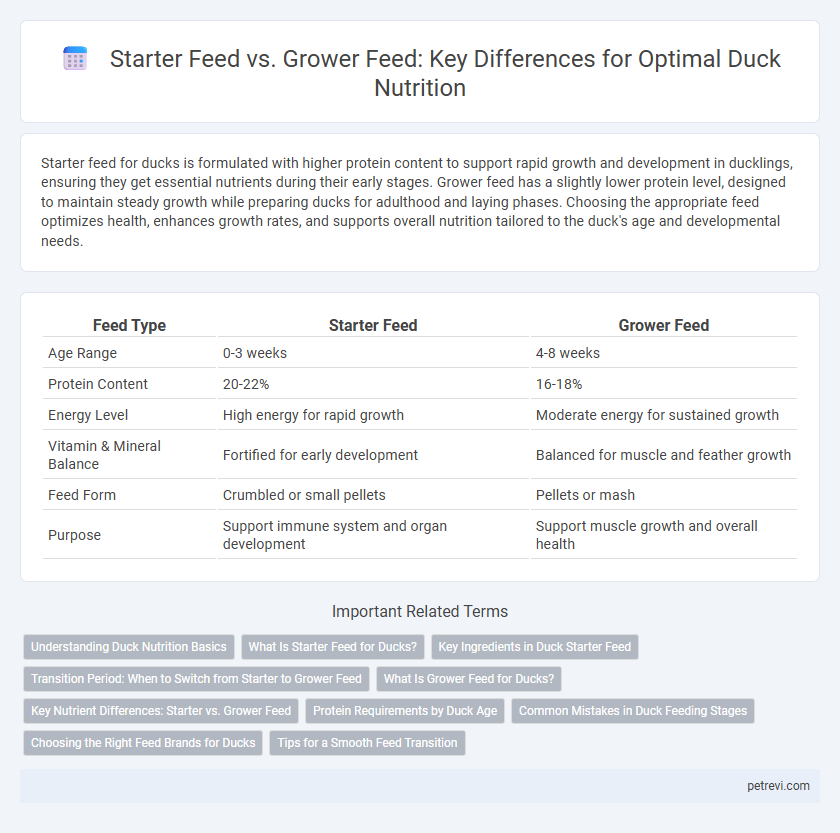Starter feed for ducks is formulated with higher protein content to support rapid growth and development in ducklings, ensuring they get essential nutrients during their early stages. Grower feed has a slightly lower protein level, designed to maintain steady growth while preparing ducks for adulthood and laying phases. Choosing the appropriate feed optimizes health, enhances growth rates, and supports overall nutrition tailored to the duck's age and developmental needs.
Table of Comparison
| Feed Type | Starter Feed | Grower Feed |
|---|---|---|
| Age Range | 0-3 weeks | 4-8 weeks |
| Protein Content | 20-22% | 16-18% |
| Energy Level | High energy for rapid growth | Moderate energy for sustained growth |
| Vitamin & Mineral Balance | Fortified for early development | Balanced for muscle and feather growth |
| Feed Form | Crumbled or small pellets | Pellets or mash |
| Purpose | Support immune system and organ development | Support muscle growth and overall health |
Understanding Duck Nutrition Basics
Starter feed for ducks contains higher protein levels, usually around 18-20%, essential for rapid growth and development during the first few weeks of life. Grower feed has a moderate protein content, typically 15-16%, supporting sustained growth and muscle formation as ducks mature. Properly balancing starter and grower feed ensures optimal nutrient intake for healthy feather development, immune function, and overall performance.
What Is Starter Feed for Ducks?
Starter feed for ducks is a specially formulated diet designed to meet the nutritional needs of ducklings during their first few weeks of life, typically from hatching to 3 weeks old. It contains higher protein levels, around 18-20%, essential vitamins, and minerals to support rapid growth, immune system development, and overall health. Proper starter feed ensures strong bone formation and optimal energy for young ducks before transitioning to grower feed.
Key Ingredients in Duck Starter Feed
Duck starter feed contains higher protein levels, typically 18-22%, crucial for supporting rapid growth and immune system development in ducklings. Key ingredients include soybean meal for essential amino acids, corn for energy, and added vitamins such as A, D, and E to promote healthy bone and feather formation. Balanced minerals like calcium and phosphorus are incorporated to support early skeletal development and overall vitality.
Transition Period: When to Switch from Starter to Grower Feed
The transition period from starter feed to grower feed for ducks typically occurs between 3 to 4 weeks of age, when ducklings begin to grow rapidly and require higher protein and energy levels to support development. Starter feeds usually contain around 20-22% protein to promote early growth, while grower feeds have slightly lower protein content, about 16-18%, to sustain steady weight gain without causing excess fat. Monitoring body weight and feather development helps determine the optimal time to switch feed, ensuring ducks receive balanced nutrition for healthy maturation.
What Is Grower Feed for Ducks?
Grower feed for ducks is a specially formulated diet designed to meet the nutritional needs of ducks during their intermediate growth phase, typically from 3 to 8 weeks of age. It contains higher protein levels, usually between 16-18%, to support rapid muscle development and overall health, compared to starter feed which has around 20-22% protein aimed at ducklings. Proper use of grower feed ensures optimal weight gain, feathering, and immune function, preparing ducks for the transition to adult maintenance or breeder diets.
Key Nutrient Differences: Starter vs. Grower Feed
Starter feed for ducks typically contains higher protein levels, around 20-22%, to support rapid growth and immune development during the first 3-4 weeks. Grower feed usually has a reduced protein content of about 16-18%, balanced with increased energy sources and essential vitamins for muscle development and feathering. Key nutrient differences include calcium and phosphorus ratios, which are carefully adjusted in grower feed to prepare ducks for eventual laying stages.
Protein Requirements by Duck Age
Duck starter feed contains 20-24% protein essential for rapid growth and immune development in ducklings up to 3 weeks old. Grower feed reduces protein levels to 15-18% to support steady muscle development and feather growth in ducks aged 3 to 8 weeks. Maintaining appropriate protein intake at each stage ensures optimal health, growth rate, and feed efficiency for ducks.
Common Mistakes in Duck Feeding Stages
Using starter feed beyond the recommended 3-week period can cause nutritional imbalances, as it contains higher protein levels suited only for ducklings. Switching abruptly from starter to grower feed may lead to digestive issues due to sudden changes in nutrient density. Failing to adjust feed composition according to growth stages often results in poor weight gain and increased susceptibility to diseases.
Choosing the Right Feed Brands for Ducks
Selecting the right feed brands for ducks involves comparing starter feed and grower feed based on their specific nutritional formulations, with starter feed typically containing higher protein levels (around 20-22%) to support ducklings' rapid growth and immune development, while grower feed offers moderate protein content (about 16-18%) for ducks transitioning to adulthood. Reputable brands like Purina, Manna Pro, and Nutrena provide specialized formulations backed by research, ensuring balanced vitamins, minerals, and amino acids essential for optimal feather quality and overall health. Prioritizing feeds with non-GMO ingredients and minimal additives can enhance digestibility and reduce health risks, promoting sustainable growth throughout the ducks' life stages.
Tips for a Smooth Feed Transition
Switching duck diets from starter feed to grower feed requires careful attention to nutrient content and gradual introduction to prevent digestive upset. Begin by mixing small amounts of grower feed with the starter feed over 5-7 days, increasing the ratio of grower feed incrementally. Ensuring consistent water availability and monitoring the ducks' feed intake helps maintain optimal growth and health during the transition.
Starter Feed vs Grower Feed for Duck Nutrition Infographic

 petrevi.com
petrevi.com